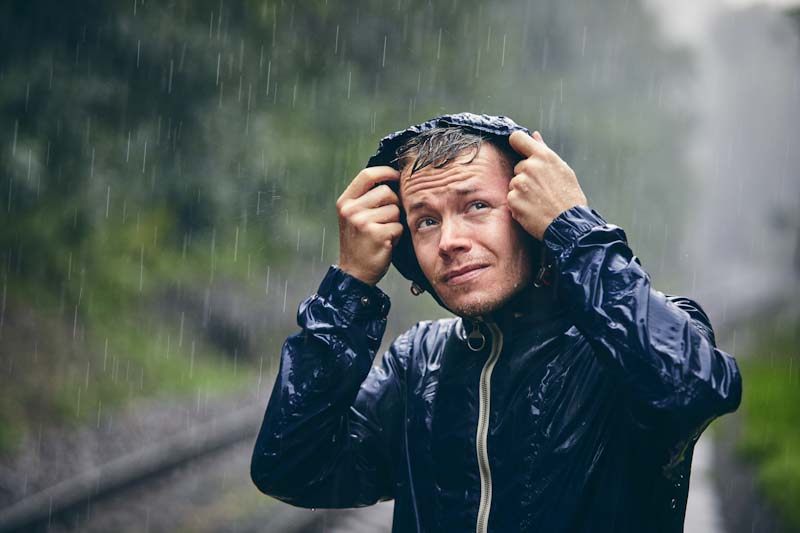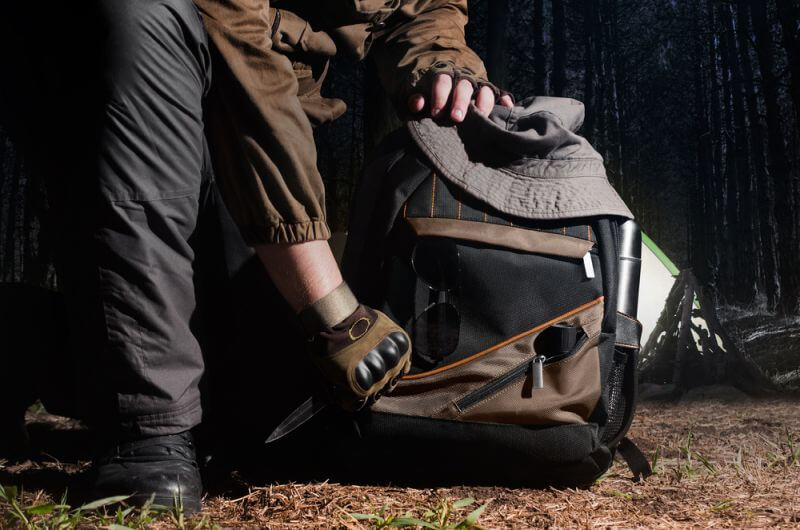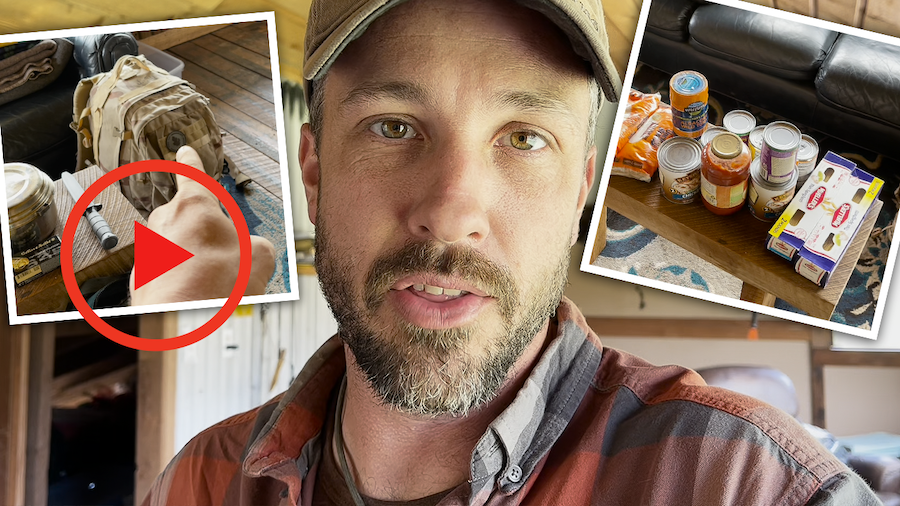There are many survival topics that hardly ever get mentioned, while others seem to be talked about by everyone. One such ignored topic is keeping dry. This should be considered a survival priority, as being wet causes us to lose body heat faster. In fact, wet clothing can cause us to lose our body heat as much as 300 times faster, depending on the fabric the clothing is made from!
I remember reading a novel, in which a man in Alaska fell into a river. Climbing out, he stripped off his clothing, even though it was well below freezing. Exercising as he worked, so that his muscles would create heat, he replaced his wet clothes with dry ones from his pack. While stripping off any clothes seems counter-intuitive in cold weather, he did exactly the right thing. About the only thing he could have done better is get indoors; but there apparently wasn’t anyplace available close by for him to do so.
I’ve long said that hypothermia is the biggest killer in the wild. While we tend to think of that only in terms of something that can happen in cold weather, it is possible to suffer from hypothermia anytime the temperature drops below our body temperature, especially if we are wet. Every summer, people die of hypothermia in the Colorado Rockies. In almost every case, they fell in the water just before sundown and were unprepared for it. Since they couldn’t get back to their cars before the first stage of hypothermia set in, they never made it back to their cars.
Dealing with cold and wet at the same time obviously isn’t a new problem, as rain has always existed and so has cold weather. Had our ancestors not come up with a solution for this problem, way back in the caveman days, it’s likely that the human race couldn’t have survived.
Waterproof Versus Water-Resistant
Before going any further, we need to get straight the difference between something being waterproof and being water-resistant. Granted, unless you’re going to wear a space suit or something similar, there’s nothing that’s truly waterproof. Water could always find a way in. But we talk about some materials being waterproof, because water can’t flow or seep through them. The emergency blankets that everyone uses are waterproof, in the sense that you could make a basin out of one of them, fill it with water and expect the water to stay there, other than any which evaporates.
The problem with materials which are waterproof, at least from the point of keeping us dry in the rain, is that they are waterproof in both directions. While they do a great job of keeping the rain out, they do just as good a job of keeping water vapor, in the form of perspiration evaporating off of our skin, in. Soldiers fighting in the Vietnam War were plagued by this, as their military rain ponchos were waterproof. They wouldn’t have to wear one long, before they were just as wet under the poncho, as they would have been if they weren’t wearing it.
The military rain poncho I’m referring to was made of rubberized fabric, with the rubber actually coating the fabric. There was also a poncho liner, made of ripstop nylon, intended to be used with the poncho during cold weather. The ripstop nylon wasn’t waterproof, but rather water-resistant. That actually made it a better poncho, than the rubberized fabric one, as ripstop nylon is water-resistant. Water will not readily soak through it, but rather bead on the surface and run off. The fabric itself can still get wet, but it doesn’t readily hold that moisture. This also means that it can breathe, allowing water vapor to pass out of the poncho.
I use a ripstop nylon rain poncho for my bug out bag, as well as for general outdoor use. Being water-resistant, rather than waterproof, it allows evaporating perspiration to escape, so I don’t get soaked in my own sweat. It’s also extremely light, which is an important factor for any bug out bag.
Modern Rainwear
We have a variety of choices for rainwear available to us today, as well as umbrellas to help keep the rain off of us. In my opinion, any sort of umbrella would probably be pretty ineffective in a survival situation. We would most likely need to be doing physical work, requiring both hands. Besides, umbrellas have a notorious tendency to be destroyed by the wind. We’ll need to stick to things we can wear. But we have to have something, so that we don’t suffer from hypothermia.
Most preppers I’ve seen carry a vinyl poncho for dealing with the rain, if they carry anything. That’s a mistake, as far as I’m concerned. Vinyl, like the rubberized fabric used for military ponchos, is waterproof, not water-resistant, meaning that they are going to hold all that perspiration inside.
The earliest modern raincoats came from a fabric sandwich invented by Scottish chemist Charles Macintosh back in 1824. His “tarpaulin fabric” which he described as “Indian rubber cloth” was made by sandwiching a core of rubber, which had been softened by naphtha, between two layers of fabric. While effective, it was heavy and of course, had the problems of all waterproof materials.
Going back further in time, furs were probably the first rainwear used in the world. Many types of animal fur are naturally resistant to the rain, providing adequate protection for people, as long as they had coats made of those types of pelts. That was fine in cold weather, but could be extremely hot during the summertime.
The rain slicker was the common rainwear of the cowboys in the Old West. Made of cured animal intestines, rain slickers were considerably lighter, breathable and somewhat transparent. First invented by the Inuit, who glued their sections of intestines together with glue made by boiling bones, the rain slicker became a standard of the Old West. Something similar was used in several other countries.
Each people group came up with their own solution. One of the more common was to make rainwear out of woven plant fibers. The Olmec Indians of Mesoamerican were the first to use rubber, creating the first rubberized fabrics. Other native people depended on the natural water resilience of the plants they used, which ranged from grasses to cedar bark. In Japan, rice straw was used.
One other interesting innovation we find in history is the use of fringe on clothing, such as the stereotypical buckskin jacket or shirt of the Old West. That fringe served an actual purpose in that it drew water out of the garment, helping it to drip off. Effective during warmer weather, something was obviously needed over the fringed buckskin during colder times.
Survival Rainwear
I’m going to assume that you have rainwear of some sort as part of your survival gear or perhaps as part of your day-to-day wear, which can be readily adapted for survival. But what if you don’t? What if whatever you have becomes damaged and you are left without rainwear? What can you do?
There are actually a number of different things that you can do to improvise rainwear, mostly taking from the types of ideas that were used in generations past. Weaving some sort of rainwear out of plants would be an easy solution, as well as something that would be available in just about any part of the world. Grasses of various types are easy to weave and should provide a fairly water-resistant overgarment, once completed.
Cedar bark is especially well suited for weaving, as it is fibrous and comes off in long stripes. Depending on how tightly one weaves those strips, the garment can be subtle or totally waterproof.
Waxing Clothes
But there are also simpler things we can do, taking existing clothing and making them water resistant. Heavy fabrics, like canvas duck, can be waterproofed fairly easily with wax. To do this, the garment must be clean and dry. It is also best if it is warm, as that will help the wax to soak into the strands.
Melt a 50/50 mixture of beeswax and paraffin in a double boiler. Spread the garment to be waterproofed out and using a stiff brush, paint the wax mixture onto it, scrubbing to work the wax into the fabric. You don’t so much want the wax sitting on the surface of the fabric, as you want it worked into it. When done properly, the finished garment will still be flexible.
If you have electricity, use a blow dryer, on high, to heat the wax further, helping it to soak into the fabric more. Then allow the garment to cool dry, spread out. Once it has cooled, bend the fabric to make sure there is no place where the wax is built up to the point where it will crack and flake off. Hold the garment up to a bright light, looking for places which might have been missed or where the wax didn’t totally soak into the fibers of the fabric. It might be necessary to do a second application, if any spots were missed.
Oiling Clothes
Another old-fashioned method that you might want to use is to oil clothing. Oil cloth was also used extensively for cloth bags to keep documents, clothing and other contents dry. Fabric luggage and duffels can be oiled to make it waterproof as well and the same process can be applied to tents which are not otherwise waterproofed.
This process is normally done with a 50/50 mixture of boiled linseed oil and mineral spirits, both of which are available at any paint store. It is the linseed oil that makes the fabric waterproof, but the mineral spirits are required, so that the linseed oil will dry and won’t end up sticky. A combination of 2 parts soybean oil and 1 part turpentine can also be used.
As with waxing clothes, when oiling them it is necessary to work the oil into the fabric with a stiff brush. The finished garment will need to be hung to dry. Leave it hanging a few extra days though, to get the smell of the oil out of the clothing. Oiling works well with cured animal hides too, as the hides will readily absorb the oil, becoming waterproof.










Shaun | April 11, 2023
|
Good info, thanx. Though the waxing of clothing may make it heavier than one might expect, and the time factor of creating it should be taken into consideration.
The 2 gallon freezer bag in my pack holds my change of clothes, all made of the “quick-dry” wicking fabrics, including the 2 pair of sox, especially.
At the bottom of the pack are a couple of heavy plastic garbage bags, and at the top is my nylon(?) poncho. My various outer coats all have SOME degree of weather resistance, just not all totally waterproof.
The wife has pretty much the same except for the garbage bags. I tried to keep her bag a little lighter than mine, in this case and a few other examples, like I have 4 ways of getting fire, she has only 2. Ounces matter especially for her.
In a pinch, if what we have goes bad, and we can’t scrounge up decent replacements , then I think I would opt for the wax over the oiling. Less work, and better chances of finding wax than linseed oil and mineral spirits. That same paint store may have 6 mil plastic drop cloths available, and or light or heavy 4’x12’ canvas runners, like I used all the time when painting. They typically have a multitude of sizes of canvas tarps.
This article is worth sharing with a buddy, thanks!
Mary-Jo Wiese | April 20, 2023
|
I am happy to see the “Recipe ” for Oilcloth ! I remember my grandparents on both sides had oilcloth tablecloths for picnics in parks & at the beach !! I have no idea what happened to them (which of our relatives got them), because I don’t recall them being ripped, torn or worn out !!
Thank You !!